What’s your brand’s mobile web conversion rate? 1 – 2%? And what’s the AOV (average order value) on your Shopify store? USD 85 – USD 100? If yes, congratulations; your online store is NOT failing or heading towards bankruptcy.
But you are nowhere close to being a success story like Shein, Nike, or Steve Madden. One last question determining whether you should keep reading is whether getting a mobile app for your brand is a waste of resources.
If you answered with a resounding yes, keep reading. We have news for you – some of these popular mobile app myths might be holding back your brand.
If you said no, and you know that you need an app, but you also think that you don’t have the time, the proper guidance, or the technological know-how, keep reading, and you’ll be surprised to learn how some of these concerns of yours are not concerns at all.
Here are the top 10 things you say that hold you back from getting a 3x-5x higher conversion rate, a 1.5 – 2x higher AOV, and an owned marketing channel that performs better than all of your existing ones.
We’re not big enough to get an app.
Do you remember the “mobile-first” wave from ten years ago? All brands, big or small, that shrugged it off and refused to pivot to mobile from desktop eventually died out. It’s the same with apps now. To survive and thrive in the app economy, you must be app-first. If you think that since you’re not as big as those industry success stories, you hear about and that having an app won’t make a difference to your brand, think again.
Irrespective of brand size, a brand’s native mobile app usually converts 3x – 5x higher than the mobile web (quite a few of the brands we built app commerce journeys for have conversion rates 10x-15x higher than mobile web). This is because mobile apps provide a much better shopping experience – they load faster than mobile web, record customer details like buying history, in-app interactions, sizing & preferences filters, and payment details, and also take advantage of mobile native features such as A.R. and V.R. (Artificial Reality, Virtual Reality).
I was wondering how much of an impact that makes. A pretty sizeable one – customers browse 286% more products and spend 18x more time in the app than on the mobile web.
The numbers from merchants we helped are similarly impressive. Smaller brands like Hobbiesville continue to grow and scale with a mobile app that contributes to 30-40% of total sales and multiplies conversions by as much as 14x! This, plus a dramatic reduction in customer acquisition costs and significantly a high LTV (lifetime value), makes a compelling case for even smaller brands to get a native mobile app.
The modern, hyper-aware customer expects you to provide a seamless & frictionless shopping experience and thinks little of brands that don’t have an app, whether you’re a small brand or an established player. So, don’t wait until you are more prominent or popular before investing in a native mobile app. Choose the right app-commerce partner, get your mobile app, and get ahead of your competition.
People won’t install the app
Customers prefer mobile apps over the mobile web. Why do you think brands like Shein, Nike, Steve Madden, and Zara have mobile apps despite having websites and even brick-and-mortar stores (in most of these cases) that do well? Because they’re following the money.
And since the latter part of the decade, not only has the money been in mobile apps, but your customers have been in mobile apps too. 57% of smartphone users prefer native mobile apps for shopping.
You see, the modern customer’s buyer journey has a multitude of digital touch points. It is no longer a linear path from discovery to purchase. Consumers have multiple channels for discovery, such as social media, targeted website ads, social proof & word of mouth, and more. There are various channels for purchase, but the most preferred one has been mobile apps for some time now. Here’s what respondents from Google’s recent market research titled “Retail Apps: Accelerated Adoption” say:
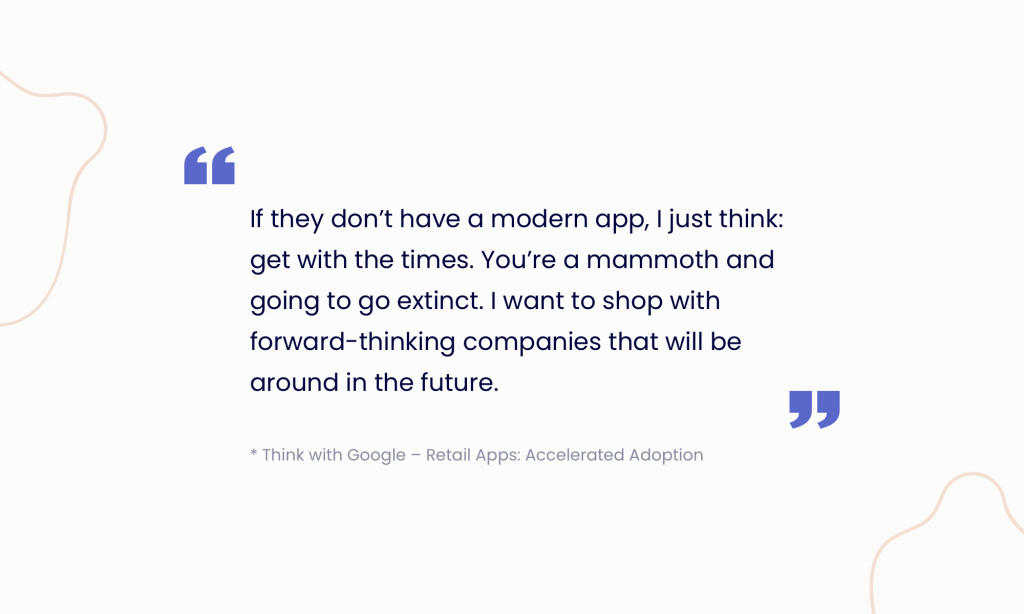
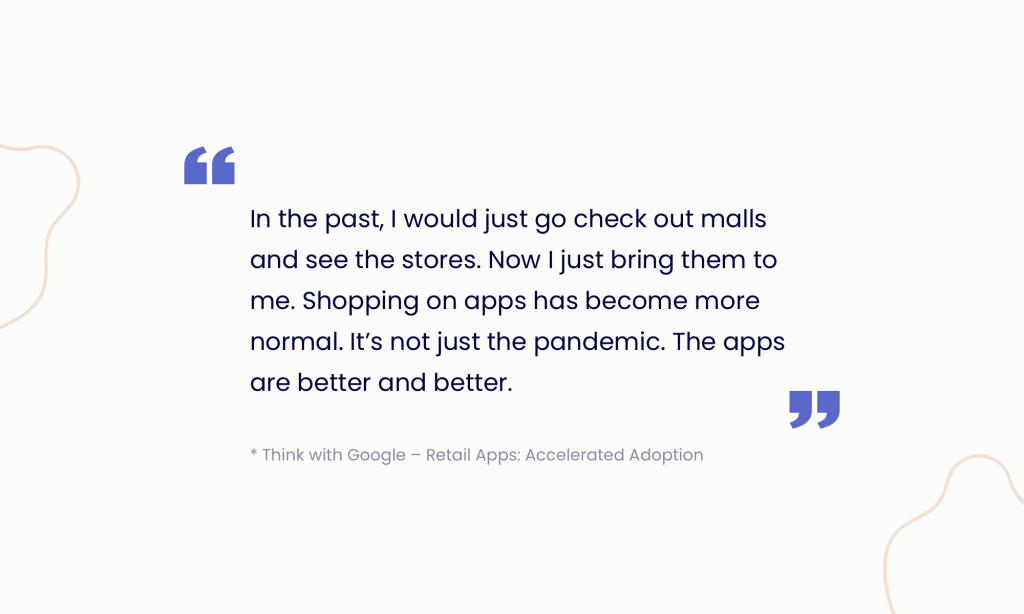
Here are some more stats that’ll make you believe that your customers want to download your app, despite data privacy considerations – according to research from Accenture and the Retail Industry Leaders Association (RILA), 63% of consumers are interested in personalized recommendations, and 64% are willing to share their data in exchange for benefits such as automatic credits for coupons and loyalty points, exclusive deals or special offers.
With an app’s push notifications, you can segment your audience and dynamically send targeted push notification campaigns when buying intent is high. Plus, if you offer exclusive products, welcome discounts, loyalty benefits, and app-only offers, customers looking for convenient shopping experiences on their preferred channels (mobile apps) will throng to your app.
Above all, if you have faith in your products and services and know that your customers love and purchase them, they will download your app and make purchases.
In our consultations, we commonly come across myths like “mobile web conversion rates are better than apps because there are too many steps involved in downloading an app and making a purchase,” But that could not be farther from the truth. To download your app, people who visit your website need to click on a “download app” banner that automatically takes them to the appropriate app store, depending on their mobile device (Android or iOS).
Once the app has been downloaded and installed, enticed by the welcome discounts or exclusive offers, customers make purchases and, impressed by the smooth shopping experiences, repeat purchases.

We’re just moving our website customers to a newer, more expensive sales channel (the mobile app)
You’ll acquire new customers with an app, retain them, and have a customer base with a high LTV (Lifetime Value). A native mobile app is a brand’s most profitable sales channel. In-app push notifications are free, but if you have to reach website customers, you have to leverage email and SMS, which are expensive and have a limited reach. Also, the AOV is higher in-app, the conversion is higher on new and repeat purchases, and the retention is consequently higher.
One of our merchants, fashion and home goods brand Trendia, multiplied their total sales by 1.7x with increased customer acquisition through its native mobile app and 23% app contribution to revenue.
Read More: How Trendia grew app revenue by 3x by switching to Plobal from another app builder
1st-time shoppers won’t purchase in the app
Yes, first-time shoppers do purchase in the app. The app isn’t only for your super fans but turns new shoppers into super fans. Our merchants routinely experience this.
How this works is when you put up a download banner on your online store with welcome discounts for in-app shoppers, in-app offers, or exclusive products, customers are incentivized to click on it and download the app. This is very effective in getting first-time shoppers to explore the app and make a purchase and benefit from your offers.
Even though most first-time shoppers are likely motivated by availing of the discount you offer, once they experience the superior shopping experience your app offers, they keep returning for more.
We don’t have enough people to design, build, and maintain this app
Traditionally, custom app development – designing, building, and maintaining a native app- requires a lot of time from your design and development experts. You and your team have too much to do, and besides, you already have this year’s roadmap in place.
But with Plobal Apps as your app commerce partner, you can either build your app in minutes with zero code or leave app designing and building to Plobal’s experts. You can be COMPLETELY hands-off and still have a fully functioning, feature-rich app that preserves the unique look and feel of your brand that your customers know and love.
But there’s more – our growth strategists and success managers can entirely run the app on your behalf and help you scale your business through your app. We’ll help you update the app as you update your website in real-time. So, you don’t have to worry about upkeep and maintenance either! It’ll be one less thing to stress about but one more thing to be proud of.
It takes months and months to deploy & launch. I don’t want the back-and-forth to be a hassle. I’m looking after too many things already.
Once you sign up, your app will be ready in 24 – 48 hours and deployed in as little as one week. You can ultimately be hands-off and rely on the team of experts assigned to you once you come on board– success managers, growth strategists, and design experts in designing building, managing, and scaling your app.
We’re Shopify Plus partners who build mobile apps as a platform for our merchants to get a bird’s eye view or an easy access control panel the same way Shopify is a platform for your online store. We integrate with all popular integrations you have on your Shopify store, making shopping a streamlined and straightforward experience.
Traditionally, apps are not a “Set-it-and-forget-it” kind of deal. But with Plobal as your app commerce partner, you can leave everything from building the app, marketing it, and engaging customers, to retaining them and making your app your most profitable sales channel to us. Here’s what your app success life cycle looks like –
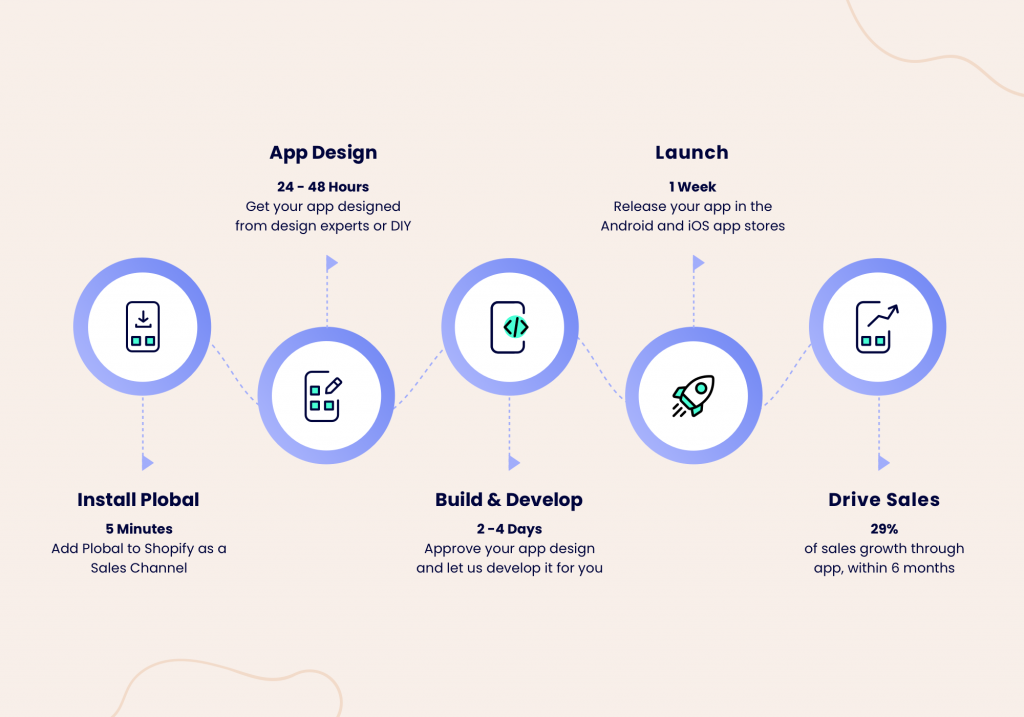
The time and money spent on app marketing can’t be justified
What if we told you that you could get millions of app downloads without spending a single dollar on ads? All it takes is an app download banner on your website that takes your customers directly to the appropriate app download store to download your app.
With app download banners, one of our merchants, GooseCreek candles, has seen as many as 60,000+ downloads in just three months. Plus, you don’t have to give it any time or bring your I.T. team into it. Our team will manage the design, coding, and deployment of it. Here’s what an app download banner looks like –
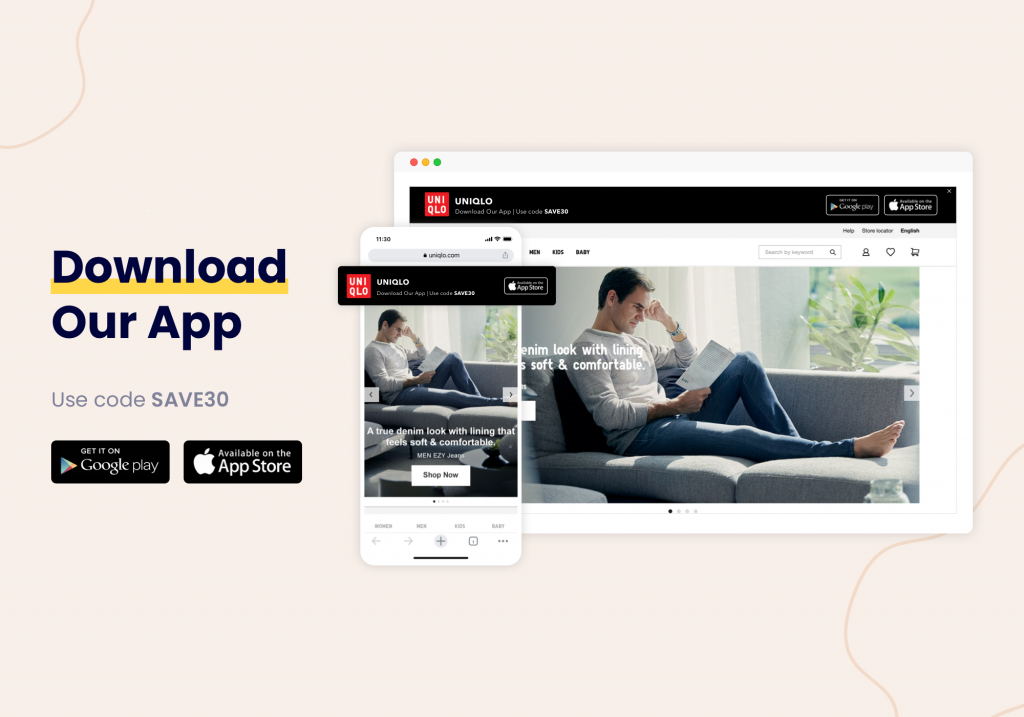
We’ll have to invest in a new set of tools and bring experts on board to measure how the mobile app performs.
The beauty of an app with Plobal Apps is the insight into user behavior, buying and browsing history, preferences & interests, and important considerations your customers make before buying.
More importantly, you get valuable data about how your push notification campaigns have been performing – what was their click rate, when your app customers clicked on them, what products were browsed after that, whether it led to the products being wishlisted, added to the cart or purchased, and more.
You also get essential metrics that matter to your business, such as the conversion rate, the AOV, the app’s contribution to sales & revenue, how your sales & discount campaigns work, and so on.
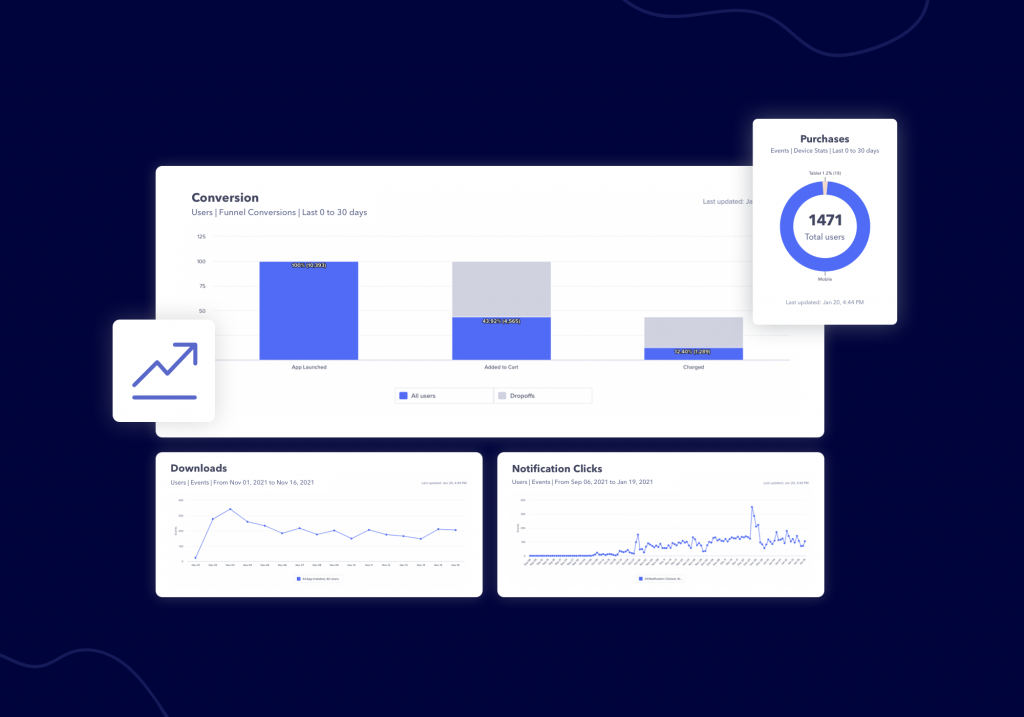
Our target demographic is too old to get another app and use it to shop.
Everyone and their mother is on Tik Tok now. And everyone and their grandma has been using retail and eCommerce apps since the pandemic. Many older users from your target age group are using shopping apps routinely to get their favorite items delivered to their doorstep and to pass the time. Even before the pandemic, mobile app use in older adults increased. Please don’t assume your shoppers are too old for an app, delight them with convenient, enjoyable shopping experiences and let them surprise you with their affinity for your mobile app and brand.
App push notifications are not necessary if you already have push notifications.
You have web push notifications on a computer, laptop, or mobile device running a supported browser. These can appear ONLY when your customer has the browser window open and ONLY if they choose to turn web push notifications on. Moreover, not every mobile device can receive web push notifications.
So, even if an iPhone or iPad has a supported browser like Chrome installed, your customers won’t be able to receive your web push notifications on their devices. Not only do most people turn off push notifications since they can obscure the content on the screen, but their reach is especially limited since your customers don’t use desktop computers to shop – more than 80% of traffic to Shopify stores comes from mobile devices.
On the other hand, app push notifications do not require the app or browser to be open. You can send segmented, highly relevant, and targeted push notifications based on details like buyer history and preferences recorded for every second the customer spends in your app.
These details remain stored for extended periods and do not expire when the customer’s user session expires as they do on the mobile web. App push notifications are more likely to be noticed since they can be sent at the correct times when buying intent is high and appear front and center on a customer’s mobile device most of the time, even if their screen is off or locked.
Additionally, you can customize app push notifications to show images, videos & GIFs, make them more relevant to customers, and nudge them to launch the app.
Web push notifications are not even close to how app push notifications effectively drive your customers to purchase.
Don’t let your misconceptions about mobile apps stop you from taking your brand to the top. Choose the right app commerce partner so that even if you have zero mobile app know-how and little to no time to give to your mobile app strategy, you too can have a successful mobile commerce journey with a powerful, feature-rich, and beautiful native mobile app. We’ve helped many merchants scale their brands and replicate the success of big brands with native mobile apps.
Are you ready to see what a native mobile app can do for you?

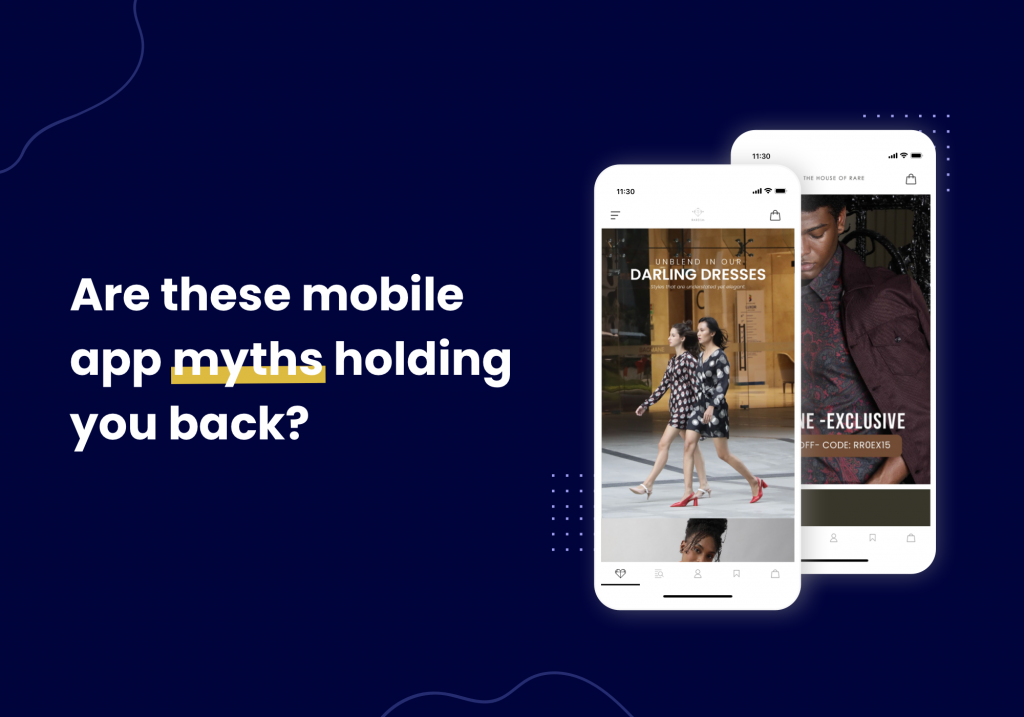
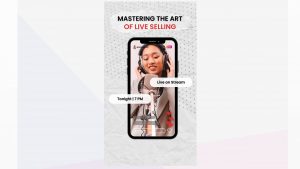
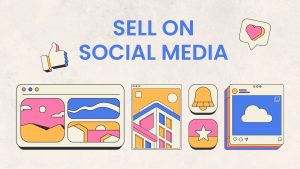
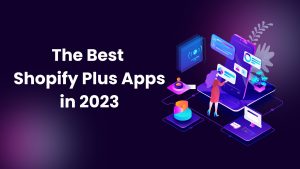
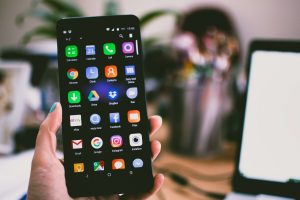
Share Your Views!